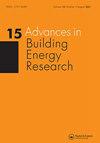Energy savings strategy for the residential sector in Libya and its impacts on the global environment and the nation economy
IF 2.5
Q2 CONSTRUCTION & BUILDING TECHNOLOGY
引用次数: 10
Abstract
ABSTRACT The energy consumption of the Libyan common house is estimated through the use of simulation namely, the TRNSYS simulation programme and other tools to reach the best solutions with the assumption of changing the behaviours of those buildings occupants into better behaviours that help in energy conservation. Using official data from The Ministry of Electricity and Renewable Energy, the Ministry of Housing and Utility, the Centre for Solar Energy Research and Studies (CSERS), measurements and a survey using a well-designed questionnaire, the relevant information is gathered and the research is conducted. The energy audit of the typical home has been conducted by using the simulation programme ‘TRNSYS’ and other tools, to identify the role and weight of each source of energy consumption in the energy savings strategy. The study provided a detailed analysis of the thermal and electrical consumption in Libyan houses. The energy audit showed that the total energy consumption was found about 16,500 kWh/year, and it is distributed by sources as 36% by electrical appliances, 24% by lighting the interior space, 15% for water heating, and about 13% for both cooling and heating the space. The estimated specific energy consumption is found as 238.7 kWh/m2 floor area. As a result, it is found that it is possible to save over 6650 TWh of electrical energy by implementing the proposed strategic plan. These savings will have a positive impact on both the economy and the environment by reducing CO2 emissions from power plants by 6.54 million tonnes of CO2 per year, saving about 1.935 million tons of burning Diesel fuel and saving about $333.54 million as social cost of the CO2. Highlights Identified the common Libyan home. Provided an inventory of electrical appliances and operating regime. Determined the specific energy consumption for the residential buildings in Libya. Determined the thermal and electrical load for the dwelling sector in Libya. Proposed a strategy to reduce energy waste in the dwelling sector. Estimated the environment and economic savings due to the implementation of the proposed strategy.利比亚住宅部门的节能战略及其对全球环境和国民经济的影响
利比亚普通住宅的能源消耗是通过使用模拟来估计的,即TRNSYS模拟程序和其他工具,以达到最佳解决方案,并假设将这些建筑物居住者的行为改变为有助于节能的更好行为。利用电力和可再生能源部、住房和公用事业部、太阳能研究和研究中心(CSERS)的官方数据、测量和使用精心设计的问卷调查,收集相关信息并进行研究。我们利用模拟程序“TRNSYS”和其他工具,对典型住宅进行能源审计,以确定每一种能源消耗来源在节能策略中的作用和权重。这项研究详细分析了利比亚房屋的热能和电力消耗情况。能源审计显示,总能耗约为16500千瓦时/年,按来源分布为电器占36%,室内照明占24%,水加热占15%,制冷和供暖占13%左右。估算的比能耗为238.7 kWh/m2建筑面积。结果发现,通过实施所提出的战略计划,可以节省超过6650太瓦时的电能。这些节省将对经济和环境产生积极影响,因为每年发电厂的二氧化碳排放量将减少654万吨,节省约193.5万吨柴油的燃烧,并节省约33354万元的二氧化碳社会成本。确定了共同的利比亚家园。提供电器和操作制度的清单。确定了利比亚住宅建筑的具体能耗。确定了利比亚住宅部门的热负荷和电负荷。提出减少住宅部门能源浪费的策略。估计因实施拟议策略而节省的环境和经济效益。
本文章由计算机程序翻译,如有差异,请以英文原文为准。
求助全文
约1分钟内获得全文
求助全文
来源期刊

Advances in Building Energy Research
CONSTRUCTION & BUILDING TECHNOLOGY-
CiteScore
4.80
自引率
5.00%
发文量
11
 求助内容:
求助内容: 应助结果提醒方式:
应助结果提醒方式:


